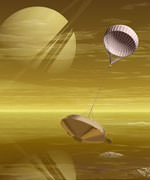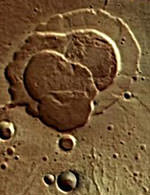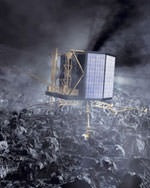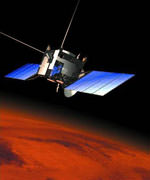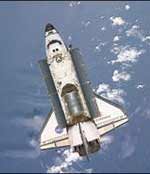
Image credit: NASA
You target NASA as being responsible for many of the problems within the space sector today. If you were given one day as NASA administrator what would you do to address the problems?
First, I would immediately initiate an independent review of all NASA centers in the context of their relevance to NASA’s new mission. Regardless of how one feels about the new Bush plan (and I have some reservations), it is the equivalent of an order to NASA from the highest office: the plan lays out what NASA is to do in coming decades, and by omission also decrees what isn’t required. Yet from the standpoint of structure and operation, the agency’s response to date has been to simply assume that one way or another, every center will be found to have some critical contribution to that new mission. That’s hard to believe; even if centers like Ames or Glenn contribute something of value to the Moon/Mars effort, it’s hard to believe a whole center is needed, along with its huge cost burden. If the center structure isn’t overhauled – which will almost certainly involve closing or consolidating one or more – it’s hard to see how the Bush plan stands a chance.
Second (and I’d probably only have time for two big things), I’d send every senior manager out into the real world – beyond the aerospace contractors, the groupies, the space media – and have them strike up conversations with ordinary people about the importance of space exploration. Much of NASA’s problem is that it’s a mutual admiration society with little connection to what those who aren’t ‘space interested’ actually think about space. I’m sure there’d be some surprises. To be fair, this problem also afflicts the alt.space sector, too.
Your book had a brief reference to Earth problems in the sense that they need to be resolved before space gets developed. In particular overpopulation and exhaustion of natural resources seem to resonate. How do you see space development advancing given these ‘Earthly’ challenges?
The first reference was to Carl Sagan’s position on human space exploration; the second, that of overpopulation and resource exhaustion, referred to Gerard O’Neill’s thinking. My own thoughts are somewhere in the middle: I think human space exploration serves a useful social purpose, yet I don’t think it’s the cure-all for humanity’s woes that some believe it to be.
There doesn’t seem to be any references to space advocacy groups outside of the United States. Is this because there are none, because they are not very vocal or because they are not germaine to the book?
Most non-U.S. space advocacy groups tend to be small; the larger ones tend to be international branches of U.S. groups like the Mars Society and Planetary Society. It’s not that they’re not important, but I felt I represented their interests in reference to the U.S. groups.
There are also very few references to other national space institutes? Is this because other countries and citizens are less interested in space?
One of my primary missions in writing this book was to deflate some of the mythology that sustained (and still sustains) the original ‘Space Age’, the theory being that only through an honest assessment of the past can one find a clear way to the future. This naturally meant focusing more on the U.S. and Soviet/Russian space programs than on the programs of other countries. I think there is another book to be written on ‘international space’, or perhaps it’s more of a long magazine article since certainly the U.S. and Russia remain the most space-interested societies on Earth (this is true even with Russia’s diminished capability). Again, there are certainly other national space programs of note and which I touch on briefly – Europe’s, Japan’s, China’s – but they’re not central to what I was trying to accomplish.
If manned space flight capability were to disappear in the next 20 years do you think it will ever reappear? If so, how?
At present, human spaceflight has little military, scientific or economic significance (except for the latter’s significance to certain aerospace contractors): from a societal standpoint, human spaceflight is an endeavor sustained almost purely on emotional terms, as a beacon of national pride, creativity and adventure. If it disappeared, it would be difficult to restart, both because of the technological challenge (look at how NASA is scrambling to figure out how to return to the Moon, something that was almost routine by 1972) and because the geopolitical rationale that produced the space race and the spaceflight technology we have today is unlikely to be replicated in the future. Thus, it’s hard to imagine a future society spending the resources and energy to develop human spaceflight unless there was some new, compelling reason.
However, I don’t think the disappearance of government-sponsored human spaceflight would necessarily mean the end of human spaceflight altogether. Within 20 years, alt.space vehicles should be robust enough to ensure that at least sub-orbital spaceflight would still be around. If government-sponsored flight went away, perhaps some of the terminated technology (and technologists) would beef up the alt.space sector sufficiently to move it from sub-orbital to orbital flight. That might not be a bad scenario, actually!
If you met a bright, energetic youth that has the aptitude for science and engineering (as in the prologue) would you encourage them to enter the space sector? If so, how? If not, where would you direct them?
If they had interest in space, I wouldn’t discourage them. But I’d encourage them first to get a job with NASA and then, quickly, to leave the agency for the burgeoning entrepreneurial sector: you have to understand the beast in order to tame it, or at least to avoid being killed by it.
I’m sure you’ve heard of the latest government call to return to the Moon and then on to Mars. Again. Any thoughts on its chances for success and on what this directive means for NASA in the short and long term?
I applaud the idea of destinations for human spaceflight, but I’m disheartened that this idea is being shoved into the same old box. The initiative seems primarily designed to reinvigorate NASA, not to reinvigorate general interest in human spaceflight. Unless someone of vision and influence can see the distinction and act on it, I’m not optimistic that the initiative will meet a fate any different than those of Bush senior or Reagan (both, you’ll recall, also announced bold Moon/Mars plans to great fanfare).
The initiative has certainly caused a lot of bustle within NASA: ‘codes’ are being formed, projects are being sketched out, etc. Meanwhile, Congress is squabbling over just the first of the budget boosts needed to make the initiative happen? and remember, this is a Bush-friendly Congress! Thus, we see again the problem with a politically driven space agenda. The best thing to come out of the initiative will probably be the retirement of the shuttle and the gradual pullout from the space station. Beyond that, at present I’d give the Moon/Mars plan a 50/50 chance of success.
I have this feeling that people are building systems that are so complex that they can’t manage them adequately whether space shuttles, 777’s or computer operating systems. Thoughts?
I don’t think complexity alone is the Achilles’ heel of any given system or device. 777s are fine machines with a great track record of functioning as advertised. I complain about my Windows OS as much as anyone, but if I step back from my irritation, it actually works quite well most of the time.
The shuttle is a disastrous machine not because of its innate complexity but because of its rube goldberg design: it’s not just complex, it’s overcomplicated? it’s a bit of this, a bit of that, all the while being sold as every cure for every problem (well, less so now, but that’s how it went originally). Worse, NASA and its shuttle contractors have known this from the beginning and yet have continued to sell the shuttle as a robust, operational vehicle. It isn’t, it never has been, and it never will be.
To me, an individual’s pursuit of life, liberty and happiness is contrary to a state project that requires effort from all taxpayers yet only benefits a few. How does space development amplify life, liberty and happiness for everyone? From reading your book I get the feeling that you disapprove of a strong central government with a lot of control. As the government gets stronger, more controlling and more centralized do you see better times or worse times for space development?
I am neither for nor against ‘big government’ as a rule. That said, I believe there are some enterprises that are absolutely the province of government, such as health care, environmental protection and education. All members of a given society deserve a minimum standard of quality where such things are concerned; it should be the responsibility of the state – or, if you like, that collective of citizens that governs and funds itself – to provide such things, and they should never be subject to the necessarily cold machinations of the market.
There are other things that can, and should, be largely removed from government control. Spaceflight is one of them, at least in part. I am obviously a fan of space exploration and space travel, but I do not consider them to be fundamental to ‘life, liberty and the pursuit of happiness’. Therefore, I see tremendous potential for the market to grab hold of certain aspects of spaceflight that are now monopolized by the government and paid for by the taxpayers: or, as you put it, which require the effort of many and benefit few.
Buy Lost in Space from Amazon.com
Interview by Mark Mortimer
